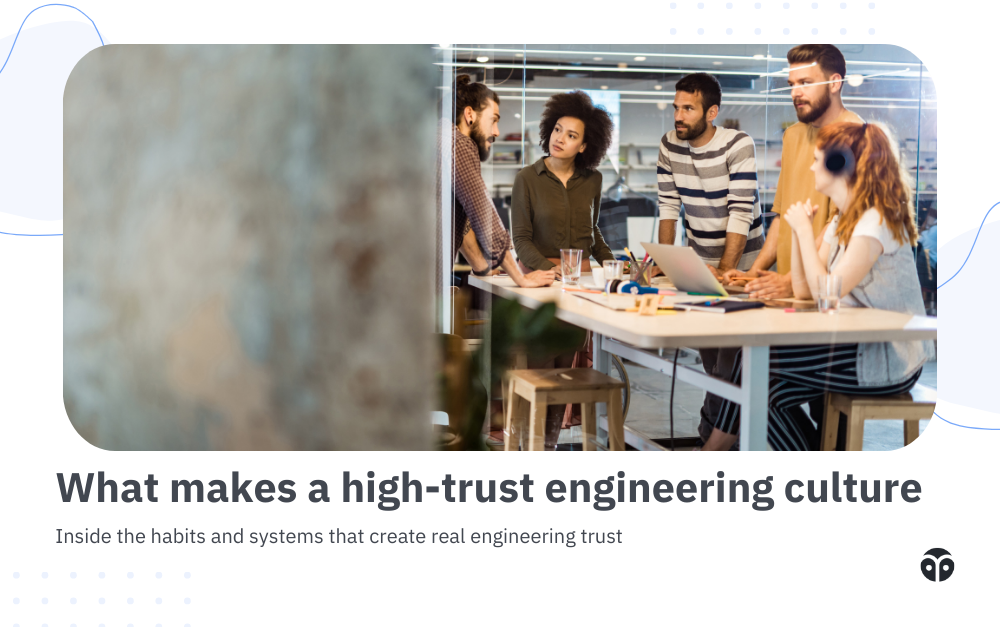What makes a high-trust engineering culture
Trust is the foundation of fast, effective teams. Here’s how high-trust engineering cultures actually work.

Ask any engineering leader what makes a team productive, and “trust” will be somewhere near the top of the list. But what does that actually mean in practice?
Trust is the operating system behind how work gets done. High-trust cultures move faster because people spend less time second-guessing, covering for gaps, or waiting for permission. They build better systems because concerns get surfaced early, and ideas flow freely. And they retain great engineers because people tend to stick around where they’re respected, empowered, and supported.
You don’t create trust with a policy or a values slide. You build it through the small, consistent ways your team communicates, makes decisions, and solves problems together.
Clarity around expectations and ownership
It’s hard to trust a team when no one’s quite sure who’s doing what, or what “done” even means.
High-trust engineering cultures create clarity. People know which parts of the codebase they own, what they’re responsible for, and how success is defined. They’re not afraid of accountability, because expectations are visible and fair.
This doesn’t require rigid org charts or micromanagement. Just a shared understanding of how work flows, who makes which decisions, and what the team is optimizing for.
In practice, this looks like:
- Clear ownership for services, systems, and shared components
- Defined decision-making roles (who decides, who’s consulted, who’s informed)
- Visible working agreements around process, estimation, and review
Psychological safety to surface ideas, risks, and concerns
Trust deepens when people feel safe telling the truth.
That includes saying “I don’t know,” flagging a concern, admitting a mistake, or suggesting something that might not work. High-trust teams don’t just tolerate this — they actively encourage it. When engineers can speak up early, problems get solved faster, and good ideas don’t get lost to fear.
Psychological safety doesn’t mean there’s never disagreement. It means disagreement isn’t punished. It’s how teams grow, adapt, and build better things together.
In teams with psychological safety:
- Engineers asking “Is this the right approach?” without fear
- No-blame postmortems that focus on systems, not individuals
- Leaders modeling vulnerability and curiosity
Consistency in how feedback and decisions are handled
Few things kill trust faster than unpredictability.
If feedback is harsh one day and vague the next, or if decisions happen behind closed doors with no explanation, people stop engaging. They second-guess the process. They hold back.
High-trust teams create consistency. Feedback has a shared structure. Decisions have a known cadence. And most importantly, follow-through is reliable: if we say we’ll revisit something next sprint, we do.
Consistency means:
- Feedback that’s timely, specific, and delivered with care
- Shared rubrics for code reviews or performance evaluations
- A place to track and explain key decisions (even the small ones)
Transparency into tradeoffs and context
It’s easier to trust a decision, even a tough one, when you understand the “why.”
Engineers don’t need to agree with every choice leadership makes. But they do need to understand the reasoning. What constraints were in play? What risks were weighed? What options were considered?
High-trust cultures default to transparency. They share not just what’s happening, but why it’s happening. And they don’t pretend every call is perfect; they just explain the tradeoffs clearly.
Some ways to promote transparency:
- Sharing rationale in planning docs and tech specs
- Project kickoff emails or Slack posts with clear context
- “What we chose not to do (and why)” sections in documentation
Empowerment and room for ownership
You can’t say “We trust engineers” and then give them no autonomy.
High-trust cultures don’t overprotect or micromanage. They give engineers room to make decisions, own systems, and try new things, with the right level of support. That trust pays off in motivation, creativity, and faster iteration.
When people feel like their work matters and that they have agency in how it gets done, they show up differently.
What this looks like in practice:
- Engineers scoping their own solutions and proposing implementation plans
- Space to run low-risk experiments and learn from them
- Teams are trusted to manage their own timelines and technical debt
Follow through on commitments
Trust is earned, not declared. And it’s usually earned in the follow-through.
If a manager says they’ll advocate for a change and never mentions it again, trust fades. If retros include the same themes every sprint with no visible progress, people disengage.
High-trust teams close the loop. They track decisions, own mistakes, and follow up on questions, whether the answer is “we’re fixing it” or “not right now, here’s why.”
In reliable teams:
- Action items from retros actually get addressed
- Managers follow up on open issues from 1:1s
- Leadership acknowledges feedback, even if the answer is no
Trust is built in the small things, over time
There’s no single behavior or ritual that creates a high-trust engineering culture. It’s a thousand tiny signals, repeated consistently.
When trust is in place, everything else gets easier, including velocity, quality, retention, and even morale. Teams don’t waste energy on politics or guesswork. They solve problems together.
It doesn’t happen overnight. But it is buildable. And it’s worth it.



